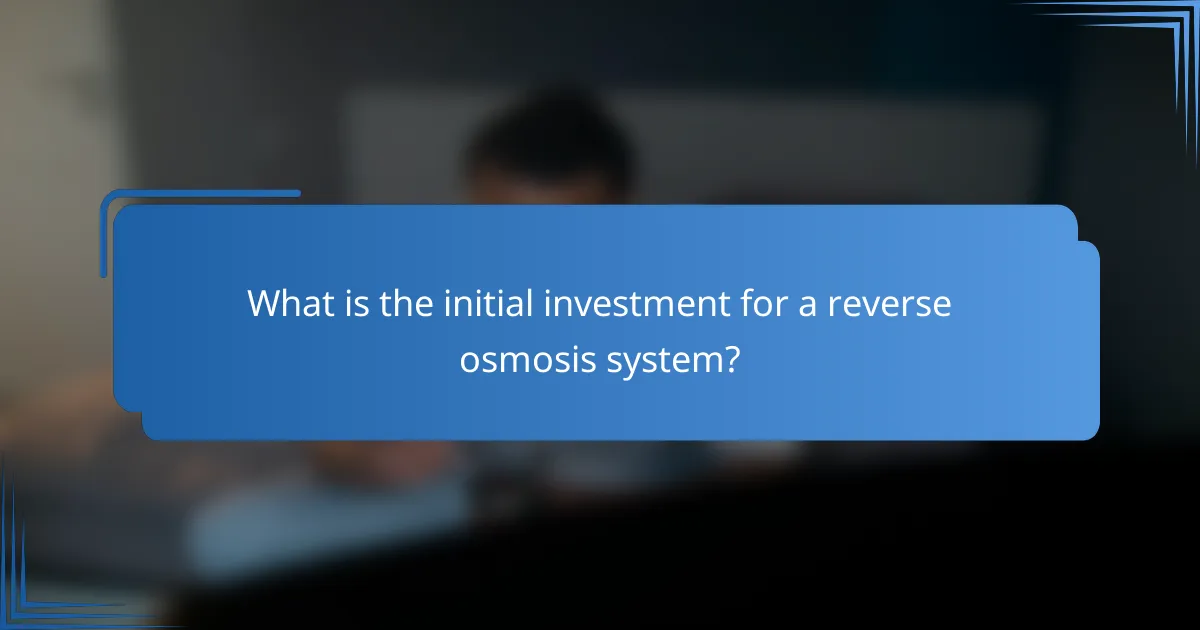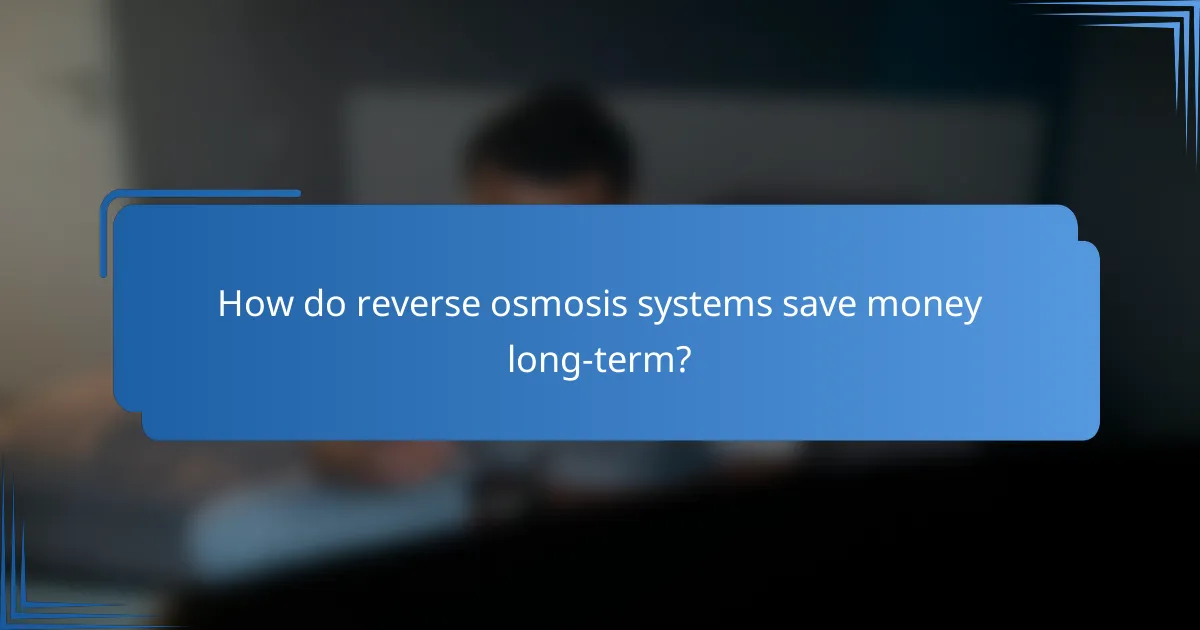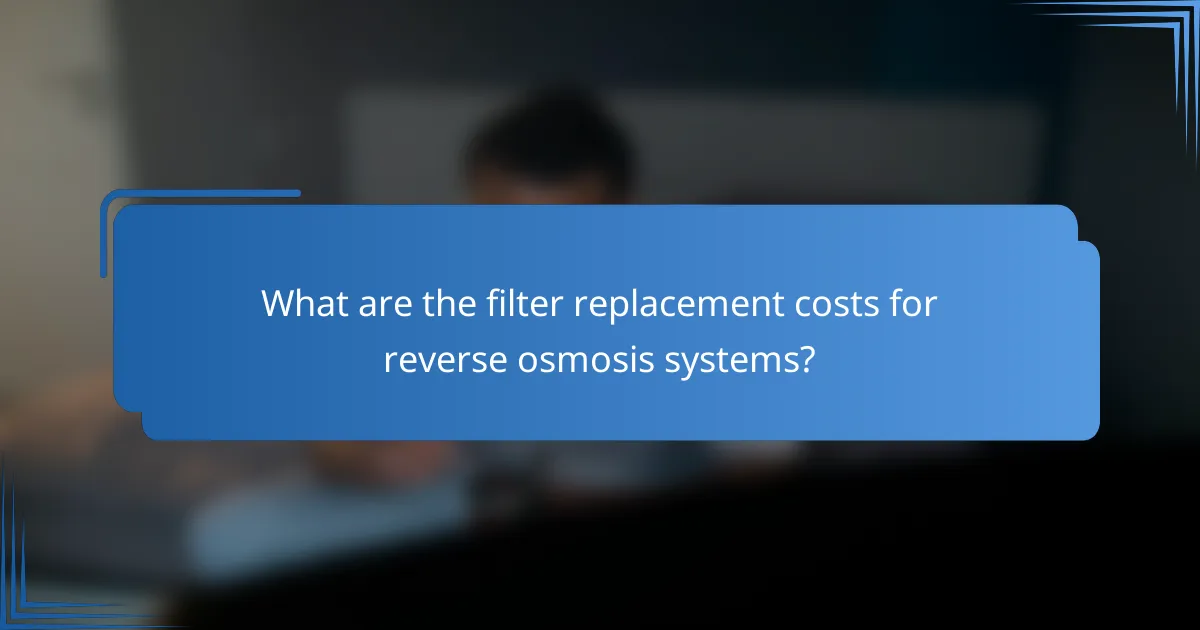A reverse osmosis system represents a significant initial investment, typically costing between a few hundred to over a thousand dollars, including installation. However, this system can lead to substantial long-term savings by reducing bottled water purchases and lowering utility bills. While homeowners should budget for annual filter replacements, usually ranging from $50 to $200, the overall benefits of clean, accessible drinking water make it a worthwhile consideration.

What is the initial investment for a reverse osmosis system?
The initial investment for a reverse osmosis system typically ranges from a few hundred to over a thousand dollars, depending on the system’s complexity and features. This upfront cost includes the price of the unit itself and any associated installation expenses.
Cost of home reverse osmosis systems
Home reverse osmosis systems generally cost between 150 USD and 600 USD for basic models, while more advanced systems can exceed 1,000 USD. Factors influencing the price include the number of filtration stages, the capacity of the system, and additional features such as UV purification or remineralization.
When selecting a system, consider both the initial cost and the long-term benefits, such as improved water quality and potential savings on bottled water. Investing in a higher-quality system may yield better performance and durability.
Installation expenses
Installation expenses for reverse osmosis systems can vary widely, typically ranging from 100 USD to 300 USD. The cost may depend on the complexity of the installation, the location of the system, and whether you hire a professional or choose to install it yourself.
DIY installation can save money but requires some plumbing knowledge. If you opt for professional installation, ensure the technician is experienced with reverse osmosis systems to avoid potential issues.
Financing options available
Many retailers and manufacturers offer financing options for reverse osmosis systems, allowing you to spread the cost over time. Look for plans that include low or zero interest rates to minimize your overall expenditure.
Additionally, some local water utility companies may provide rebates or incentives for installing water filtration systems, which can help offset the initial investment. Always check for available programs in your area to maximize savings.

How do reverse osmosis systems save money long-term?
Reverse osmosis systems save money over time by reducing the need for bottled water, lowering utility bills, and extending the lifespan of household appliances. These systems provide a cost-effective solution for clean drinking water while minimizing ongoing expenses related to water consumption and maintenance.
Reduction in bottled water purchases
One of the most immediate financial benefits of a reverse osmosis system is the significant reduction in bottled water purchases. Families can save anywhere from a few hundred to over a thousand dollars annually by eliminating the need to buy bottled water, especially in areas where water quality is a concern.
By investing in a reverse osmosis system, households can enjoy clean, filtered water directly from the tap, which not only cuts costs but also reduces plastic waste. This shift can lead to both environmental and economic benefits.
Lower utility bills
Reverse osmosis systems can contribute to lower utility bills by improving water efficiency. These systems typically use less water than traditional filtration methods, with many operating at a ratio of 1:3, meaning for every gallon of purified water, only about three gallons are wasted.
In addition, having cleaner water can lead to less buildup in plumbing and appliances, which can help maintain water flow and efficiency, further reducing utility costs over time. Regular maintenance of the system ensures optimal performance and savings.
Increased lifespan of appliances
Using a reverse osmosis system can prolong the lifespan of appliances that use water, such as dishwashers and refrigerators. The removal of impurities and minerals from the water reduces the risk of scale buildup, which can damage appliances and lead to costly repairs or replacements.
By providing high-quality water, reverse osmosis systems help maintain appliance efficiency and performance, ultimately saving money on repairs and extending the life of these essential household items. Regular filter replacements are necessary, but the overall savings on appliance longevity often outweigh these costs.

What are the filter replacement costs for reverse osmosis systems?
The filter replacement costs for reverse osmosis systems can vary significantly based on the type of filters used and the specific system. Generally, homeowners should expect to spend anywhere from $50 to $200 annually on replacement filters, depending on their usage and the quality of the filters selected.
Average cost of replacement filters
The average cost of replacement filters for reverse osmosis systems typically ranges from $30 to $150 per set. Standard filters, including sediment and carbon filters, are usually on the lower end, while more advanced membranes can be pricier. For example, a reverse osmosis membrane might cost between $50 and $100, while pre-filters can be found for around $20 to $50 each.
Frequency of filter changes
Filter changes for reverse osmosis systems are generally recommended every 6 to 12 months, depending on water quality and usage. The membrane itself may need replacement every 2 to 3 years. Regularly monitoring water quality can help determine when filters should be replaced to maintain optimal performance.
Cost comparison with other filtration systems
When comparing reverse osmosis systems to other filtration options, such as activated carbon filters or pitcher filters, the costs can differ significantly. While activated carbon filters may have lower initial costs, they often require more frequent replacements, which can add up over time. In contrast, reverse osmosis systems have higher upfront costs but can provide more comprehensive filtration, potentially leading to long-term savings on bottled water and health benefits.

What factors influence the choice of a reverse osmosis system?
The choice of a reverse osmosis system is influenced by several key factors, including water quality, household size, and brand reputation. Understanding these elements can help you select a system that meets your specific needs effectively.
Water quality assessment
Assessing your water quality is crucial when choosing a reverse osmosis system. Testing for contaminants such as lead, chlorine, and total dissolved solids (TDS) will guide you in selecting a system that effectively addresses your specific water issues.
Many local water suppliers provide annual water quality reports, which can serve as a starting point. If your water has high TDS levels, look for systems designed to handle those levels efficiently.
Household size and consumption
Your household size and daily water consumption significantly impact the type of reverse osmosis system you should choose. Larger families typically require systems with higher output capacities to ensure a steady supply of purified water.
As a general guideline, consider systems that can produce at least 50 gallons per day for average households. For larger families or higher consumption needs, systems that offer 75 gallons per day or more may be necessary.
Brand reputation and warranty
Brand reputation plays a vital role in the reliability and longevity of reverse osmosis systems. Researching customer reviews and ratings can provide insights into the performance and durability of different brands.
Additionally, consider the warranty offered by the manufacturer. A longer warranty period often indicates confidence in the product’s quality and can protect your investment over time.

What are the maintenance requirements for reverse osmosis systems?
Reverse osmosis systems require regular maintenance to ensure optimal performance and longevity. Key tasks include filter replacements, system checks, and monitoring water quality to prevent issues.
Routine maintenance tasks
Routine maintenance for reverse osmosis systems typically involves replacing pre-filters and post-filters every 6 to 12 months, depending on water quality and usage. The membrane itself may need replacement every 2 to 5 years. Regularly checking for leaks and ensuring the system is clean can prevent larger issues.
Additionally, sanitizing the system annually can help eliminate bacteria and other contaminants. Keeping track of filter replacement schedules and water quality tests can simplify maintenance and enhance system efficiency.
Signs of system failure
Common signs of reverse osmosis system failure include a noticeable decrease in water pressure, unusual tastes or odors in the filtered water, and visible leaks around the system. If the system produces a higher than normal amount of wastewater, it may indicate a problem with the membrane or filters.
Monitoring the total dissolved solids (TDS) levels in the water can also help detect issues. Elevated TDS levels could suggest that the membrane is failing and needs replacement. Regular checks can help catch these problems early, preventing costly repairs.
